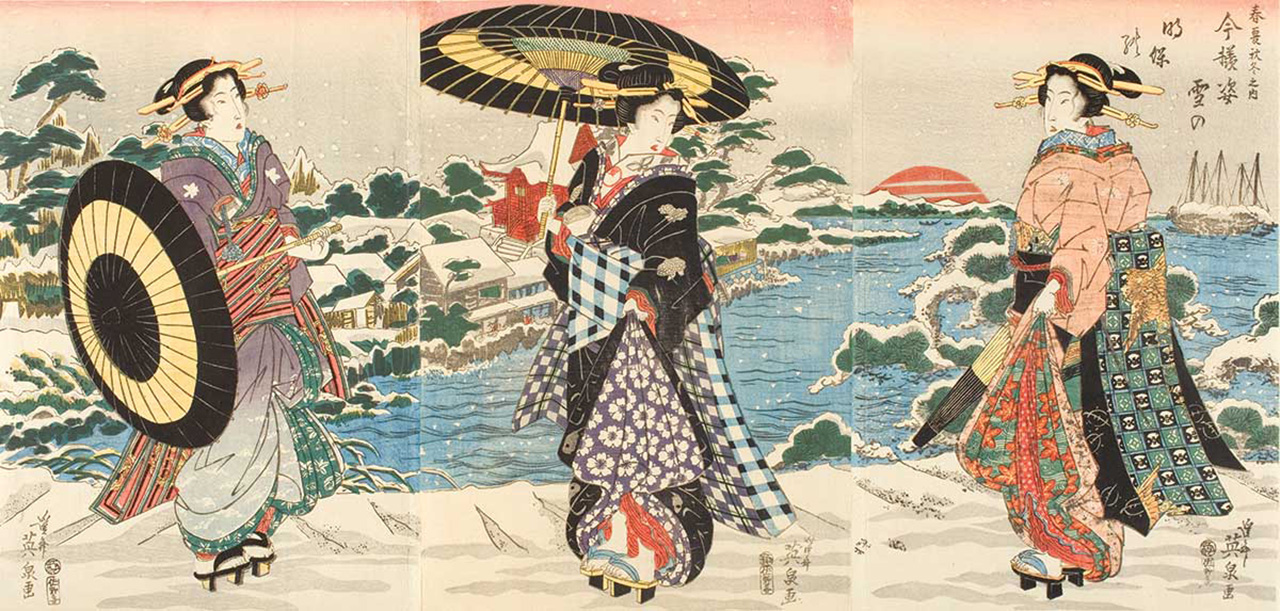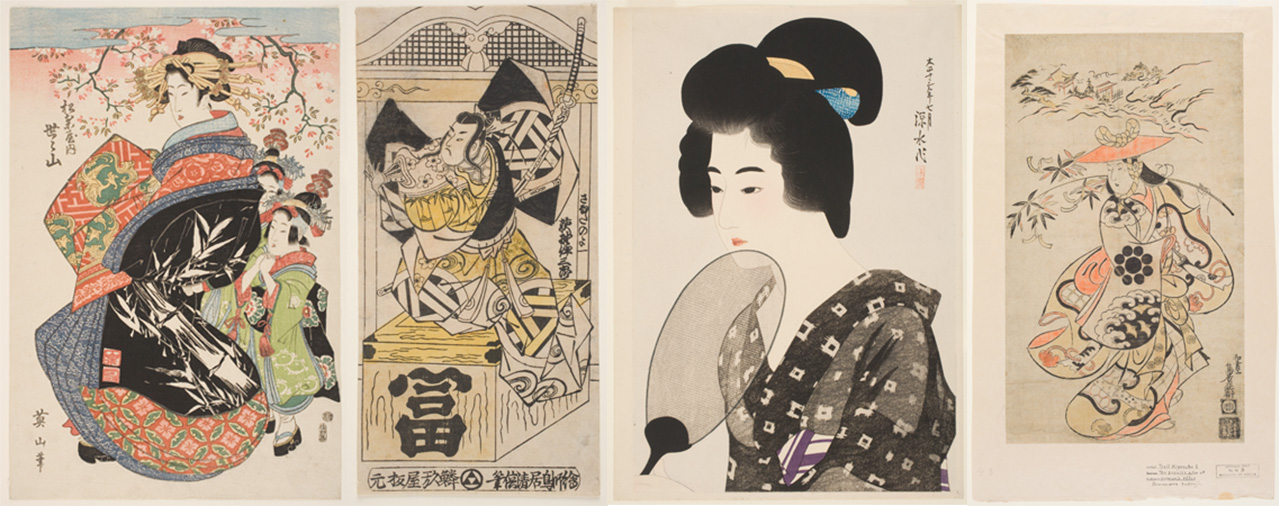Exhibition - The Kimono in Print: 300 Years of Japanese Design
Worcester Art Museum (WAM), Massachusetts (US)
(6 February - 2 May 2021)
Review by Fiona Collins
The first thing one encounters when walking into The Kimono in Print: 300 Years of Japanese Design, on view at the Worcester Art Museum (WAM), is a resplendent white wedding robe bedecked in colorful, abstracted maple leaves. Commissioned by the museum from Kyoto-based Chiso Studios, it stands on a platform in the center of the museum’s one room exhibition, acting as a focal point for the entire show. As the only actual garment, and the most modern object by over a hundred years, it is a response to the central question posed: how have kimonos acted as a canvas for people’s evolving relationship with modernity in Japan?

Keisai Eisen (1790–1848), Modern Figures on a Snowy Day, early to mid-1820s, from the series The Four Seasons, Publisher: Sanoya Kihei, color woodblock print with graduated colors (bokashi) and blind-printing (karazuri), John Chandler Bancroft Collection, 1901.146
This exhibition focuses primarily on how kimonos reflected major socio-economic shifts in the Edo period (1603-1868), a time which witnessed a rapidly changing consumerist culture in Japan. Many of these changes were facilitated by the growing population of urban elite (composed mostly of samurai and aristocrats) who flocked to cities and patronized the trade of those traditionally regarded as belonging to the lowest tier within traditional Japanese social stratification, such as artisans, merchants, and actors. Co-mingling in the metropolitan demimonde known as ukiyo, literally translated to “the floating world”, these two groups championed popular entertainment and indulgent expenditure, often living beyond their means in pursuit of ephemeral pleasures. Ukiyo-e (lit. pictures of the floating world) capture its zeitgeist, and show how the new class dynamics and preoccupation with fashion were reflected in contemporary design.
With over 70 objects -including prints, paintings, catalogues, and handscrolls- from the Museum’s collection, visiting curator Vivian Li exposes an dialogue between this evolution in print culture and the history of costume in Japan from the 17th century onward; The former served to document and disseminate new trends to fashion-conscious, and frequently acted as a source of inspiration for new ones. Much of the incredible vibrancy and expressive power of the prints was precipitated by the introduction of new technologies, methods, and materials in this period, which enabled artists to more accurately represent the intricacies of textiles. After months of quarantine, the show is refreshingly interactive, the picture labels encouraging viewers to look from all angles in order to catch details like the shimmer of metallic pigments or the textures (intentionally) created by exerting extra force when pressing woodblock to paper.
Kimono in Print stands apart from other exhibitions focusing on Japanese design because it ultimately forces the viewer to think from the perspective of the consumer. The costumes themselves, or rather their depictions in print, are almost secondary to what they meant to the people who aspired to wear them. It asks and answers questions such as: Who was buying them? How were they gendered? Who would have recognized the subtextual meanings of certain designs? Which print formats were suited to private viewing, and which for mass consumption? By using this approach, the show exposes the diverse tastes of people seeking to distinguish themselves in an increasingly visual culture.
Understandably, in the pandemic it might be hard for potential visitors to make it to the Worcester Art Museum. Luckily, the same team that curated Kimono in Print developed the digital exhibition Kimono Couture: The Beauty of Chiso, which explores the wedding robe mentioned above and the 466 year old shop in Kyoto that produced it. Separated into eleven parts (Introduction to Chiso, What is a kimono?, Materials of a kimono, Decorative Techniques, Making a Kimono, Artistic collaboration, Designing a kimono, Symbolism, Ceremonies and kimono, and Worcester Wedding Kimono Part I&II) and replete with vivid photographs, it can be viewed as a exhibition in traditional sense or a treated as a comprehensive digital archive.
The curator of Kimono in Print created Kimono Couture at the height of the pandemic last year in collaboration with Christina Starkman and Rachel Parikh, Assistant Curator of Asian Art at WAM. Although the format obviously presents limitations for viewers, it expertly maximizes the potential of online platforms to captivate audiences through interactive pages and beautiful web design. Each section (named above) is like a work of art unto itself, delving into what kimonos are and what multimedia techniques were (and are still) used to make them. Interestingly, to add to the sense of experiential immediacy and engagement that can be lost in digital exhibitions, the curators chose to stagnate their release over the course of ten weeks when it was first opened in 2021.
The two shows undoubtedly enrich each other; Kimono Couture comes across as a sequel of sorts to Kimono in Print and presents the work of Chiso as a part of the same continuum as the Edo period kimono industry. There is particular emphasis on the place of kimono in modern visual culture today and how designers continue to use them as a source of inspiration. For those more familiar with the subject, they will appreciate how rare it is to get an exclusive look inside a studio of such quality and historic importance.
In short, I would highly recommend anyone with an interest in fashion, history, or the arts of Asia to check out either exhibition. Both shows offer an opportunity to look up close at the exquisite craftsmanship of the objects featured, and are an exciting refinement of a well studied subject.
Kimono in Print is on view at the Worcester Art Museum (WAM) until 2 May 2021. Information about the show can be found on the museum website. The exhibition is accompanied by a catalog edited by guest curator Vivian Li, with contributions by Nagasaki Iwao, Ellis Tinios, Matsuba Ryoko, Fujita Kayoko, and Stephanie Su. Published by Hotei Publishing, in association with the Worcester Art Museum. Kimono Couture: The Beauty of Chiso is accompanied by the catalog Kimono Couture: The Beauty of Chiso, written by Vivian Li and Christine Starkman with contributions from Riyo Kikuchi and Yukio Lippit.

From left to right:
1) Kikugawa Eizan (1787–1867), The Courtesan Yoyoyama of the Matsubaya with Her Two Young Female Attendants Standing Under Branches of Cherry Blossoms, ca. 1830, Publisher: Sanoya Kihei, color woodblock print with blind-printing (karazuri) and graduated colors (bokashi), John Chandler Bancroft Collection, 1901.59.2650
2) Torii Kiyomasu II (1706–50), The Kabuki Actor Ogino Isaburō I as Sanada no Yoichi, 1735, Publisher: Urokogataya Magobei, woodblock print with hand-applied color (beni-e), and metal filings, John Chandler Bancroft Collection, 1901.59.2130
3) Itō Shinsui (1898–1972), Woman with Marumage Hairstyle, 1924, Publisher: Watanabe Shōzaburō, color woodblock print on mica (kirazuri) ground, Gift of Edward Kenway, 1960.7
4) Torii Kiyonobu I (1664–1729), The Kabuki Actor Sawamura Kodenji I as Tsuyu no Mae, 1698, Publisher: Hangiya Shichirōbei, woodblock print with hand-applied color (tan-e), John Chandler Bancroft Collection, 1901.59

